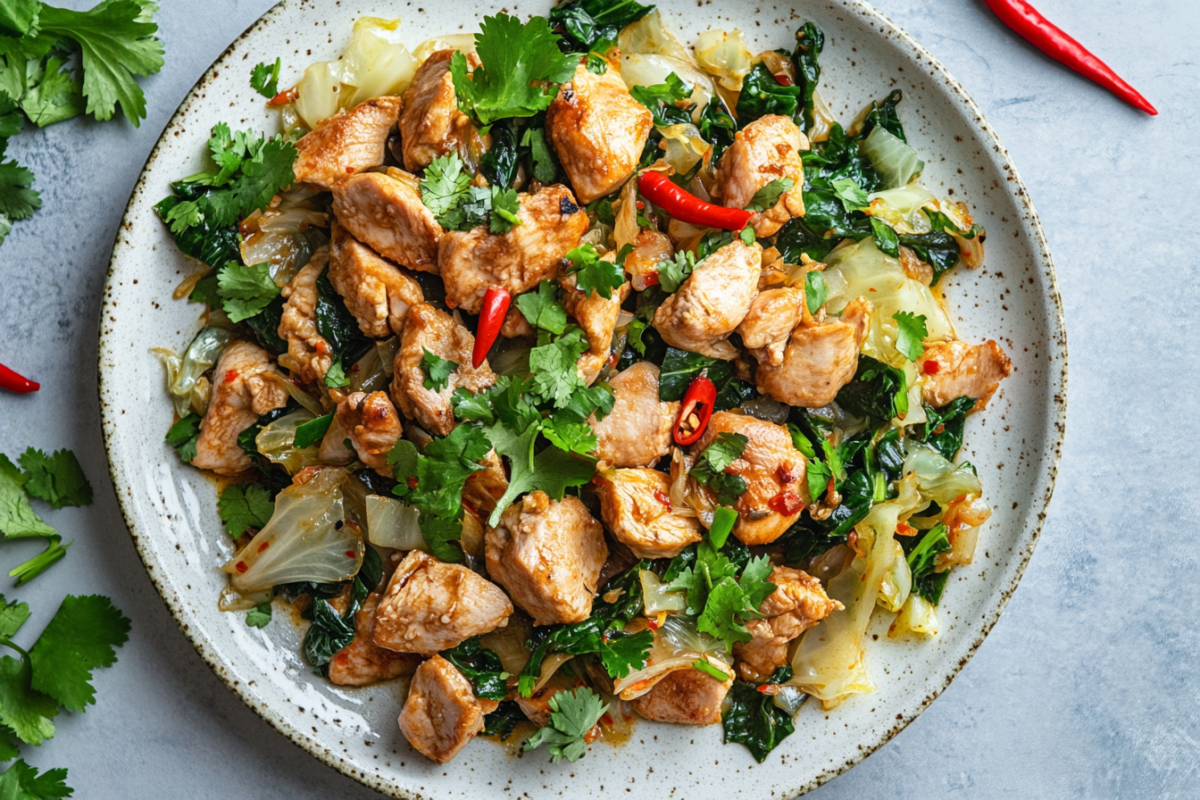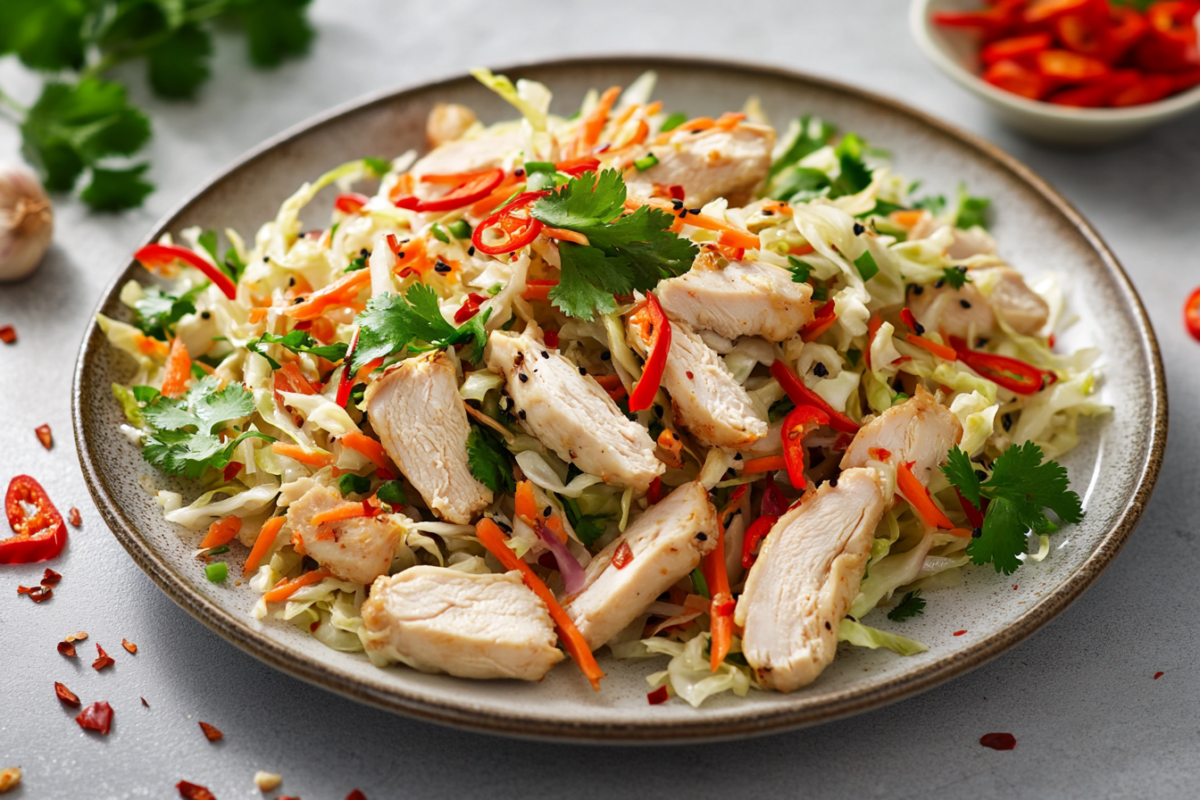Are you ready to try a dish that’s packed with flavor, history, and tradition? Hmong cabbage and chicken is a unique recipe that combines tender chicken with fresh, crunchy cabbage, all stir-fried together in a mouthwatering sauce. This dish is not only a delicious blend of flavors but also holds a special place in the hearts of Hmong communities. Whether you’re new to Hmong cuisine or already a fan, this recipe is sure to impress with its balance of spices and wholesome ingredients. In this article, we’ll take you step-by-step through the history, ingredients, and methods to create this authentic dish in your own kitchen.
What Is Hmong Cabbage and Chicken?
Origin of Hmong Cabbage and Chicken Recipe
The Hmong cabbage and chicken recipe has its roots in the traditional dishes of the Hmong people, an ethnic group with a rich culinary history. Native to regions in Southeast Asia, particularly Laos, Vietnam, and Thailand, the Hmong have long been known for their flavorful and simple yet hearty dishes. This recipe embodies the spirit of Hmong cooking—seasoned with fresh, locally-sourced ingredients that are stir-fried to perfection.
Hmong cuisine often uses fresh vegetables like cabbage and a variety of herbs and spices. The combination of chicken and cabbage creates a savory dish that is both nutritious and satisfying. Though it varies slightly by region, this dish has become a beloved comfort food for many.
Why Is This Dish So Popular?
Hmong cabbage and chicken has earned its place as a family favorite for its simplicity and bold flavors. This dish isn’t just about feeding the body—it’s about bringing people together. It’s the type of meal you can serve at a family gathering or a casual dinner, and it’s flexible enough to adapt to different tastes. Plus, it’s easy to make, especially when you’re working with fresh ingredients that pack in flavor without the need for complicated techniques.
Another reason for its popularity is its versatility. You can adjust the spice levels to your liking, add more vegetables, or even swap the chicken for another protein. Whether you’re in the mood for a light meal or something more substantial, this Hmong stir-fry with chicken can be tailored to fit your needs.
Understanding the Key Ingredients
Key Ingredients in Hmong Cabbage and Chicken
Creating the perfect Hmong cabbage and chicken dish starts with the freshest ingredients. Each element plays a role in building the flavors and textures that make this recipe so special. Let’s take a closer look at the key ingredients that make this dish a true delight.
Fresh Cabbage and Its Role in the Recipe
Cabbage is the star vegetable in this dish, offering a crisp texture and subtle sweetness that pairs perfectly with the other ingredients. It’s typically shredded or cut into thin strips, allowing it to absorb the flavors of the sauce while still retaining its crunch. Cabbage’s mild flavor balances the boldness of the spices and the richness of the chicken.
Not only is cabbage essential for its taste and texture, but it also adds nutritional value. It’s low in calories, high in fiber, and packed with antioxidants, making it an excellent addition to your diet. Plus, it’s a key component in many traditional Hmong dishes, showcasing the connection to the natural, wholesome foods that define this cuisine.
Chicken: The Heart of the Dish
The chicken is undeniably the heart of the Hmong cabbage and chicken recipe. Often, skinless, boneless chicken thighs are used for their tenderness and flavor, but boneless breasts work just as well. When cooked correctly, the chicken becomes juicy and flavorful, absorbing the sauce and spices during stir-frying.
This dish typically uses bite-sized pieces of chicken that cook quickly, ensuring that they remain tender without becoming dry. The protein is the perfect complement to the cabbage, bringing richness and a satisfying substance to the dish. Without the chicken, the dish would be lacking that key savory flavor, making it an essential element.
Seasonings and Spices
The magic of Hmong cabbage and chicken comes from its seasonings and spices. The recipe uses a mix of fresh garlic, ginger, and soy sauce, along with fish sauce, to bring the dish to life. These ingredients work together to create a balanced umami flavor profile that enhances both the chicken and the cabbage.
In addition to the basic seasonings, a touch of sugar or a splash of vinegar may be added to balance the flavors and elevate the dish’s taste. The use of aromatic herbs and spices ensures that every bite is packed with flavor, making the dish even more enjoyable.
Step-by-Step Hmong Cabbage and Chicken Recipe

Preparing the Ingredients for Hmong Cabbage and Chicken
Now that we know the key ingredients, let’s dive into the step-by-step process for making Hmong cabbage and chicken. Preparing the ingredients properly is crucial to getting the best flavors and textures from the dish. Here’s how to get started.
How to Prepare Fresh Cabbage
The first step is to prepare your fresh cabbage. Start by removing any outer leaves that might be damaged or wilted. Then, rinse the cabbage thoroughly under cold water to remove any dirt or pesticides. Once it’s clean, cut the cabbage in half, and then in quarters. From here, you can either shred it using a sharp knife or a mandoline slicer. Shredding creates thin, uniform strips that cook evenly, soaking up all the delicious stir-fry sauce.
If you prefer a heartier texture, you can also chop the cabbage into larger pieces. However, smaller pieces tend to cook faster and absorb the seasonings better, making them a popular choice in many Hmong stir-fry recipes. After shredding, set the cabbage aside, ready for stir-frying.
Preparing the Chicken for Cooking
Next, it’s time to prepare the chicken. You can use boneless, skinless chicken thighs or breasts—both work well for this dish. Begin by trimming off any excess fat from the chicken, as it can become greasy when cooking. Then, cut the chicken into bite-sized pieces, ensuring they are roughly the same size for even cooking.
To enhance the flavor, marinate the chicken for at least 15 minutes. A simple marinade made of soy sauce, garlic, and a dash of fish sauce works wonders. This not only infuses the chicken with flavor but also helps keep it tender during cooking. After marinating, drain any excess liquid, and your chicken is ready to be stir-fried.
Cutting and Chopping Techniques
When preparing the ingredients, cutting and chopping techniques are important for consistency and even cooking. For the cabbage, a sharp knife or mandoline will give you clean, uniform strips that cook faster and ensure a balanced texture. If you’re using a knife, make sure it’s sharp enough to avoid crushing the cabbage, as you want to retain that crispy texture.
For the chicken, make sure to cut it into uniform pieces, as uneven sizes may result in some pieces overcooking while others remain undercooked. This consistency helps the dish cook evenly, ensuring that every bite is perfect.
Preparing the Stir-fry Sauce
The stir-fry sauce is the heart of this Hmong cabbage and chicken recipe, giving it the bold and savory flavor you’re craving. To make the sauce, start by combining soy sauce, fish sauce, minced garlic, and freshly grated ginger in a small bowl. Add a teaspoon of sugar to balance out the saltiness of the sauces, and a small splash of vinegar for a touch of acidity. You can also add a dash of chili sauce if you want to give the dish a little heat.
Once your sauce is prepared, set it aside, ready to be added to the pan when cooking. This sauce is the key to bringing all the ingredients together and creating that deep, rich flavor that makes this dish so irresistible.
Cooking Methods
How to Cook Hmong Cabbage and Chicken
Now that your ingredients are prepped, it’s time to bring everything together. Cooking Hmong cabbage and chicken is a straightforward process, but the technique makes all the difference. Let’s dive into the stir-frying and simmering process that transforms this dish into something truly special.
Stir-Frying the Chicken and Cabbage
Begin by heating a large wok or a deep skillet over medium-high heat. Add a tablespoon of oil (vegetable or peanut oil works best) and let it heat up until it shimmers. Once the oil is hot, add the marinated chicken in batches, being careful not to overcrowd the pan. Stir-fry the chicken for about 3-5 minutes, or until it’s golden brown and cooked through. You want to get a nice sear on the chicken for added flavor and texture.
Once the chicken is cooked, remove it from the pan and set it aside. In the same pan, add a little more oil if necessary and toss in the shredded cabbage. Stir-fry the cabbage for 2-3 minutes, just until it starts to soften but still retains its crunch. Then, return the cooked chicken to the pan with the cabbage, ready for the next step.
Simmering the Dish for Flavor
The real magic happens when you add the stir-fry sauce to the pan. Pour the sauce over the chicken and cabbage mixture, ensuring it coats everything evenly. Lower the heat to medium and let the dish simmer for 5-7 minutes, allowing the sauce to reduce and thicken slightly. This simmering step lets all the flavors meld together, infusing the chicken and cabbage with the savory, aromatic sauce.
You’ll notice the cabbage softens further, absorbing the sauce, while the chicken becomes even more flavorful. This is where the dish really comes to life, and the savory goodness shines through. Taste and adjust the seasoning if needed, adding a pinch of salt or sugar to balance the flavors to your liking.
The Importance of Temperature and Timing
Getting the temperature and timing just right is crucial to achieving the perfect Hmong cabbage and chicken. Stir-frying over too low a heat will leave the ingredients soggy, while cooking over too high a heat might burn them. Medium-high heat is optimal, allowing the chicken to get a good sear and the cabbage to cook quickly while still maintaining its crunch.
In terms of timing, be mindful of not overcooking the cabbage. You want it tender but not mushy. The same goes for the chicken—if overcooked, it can become dry and tough. Stir-fry in batches to ensure everything cooks evenly and you get the ideal texture and flavor in every bite.
Tips for Making the Perfect Hmong Cabbage and Chicken
Pro Tips for a Delicious Hmong Cabbage and Chicken
Making the perfect Hmong cabbage and chicken doesn’t require advanced skills—just a few tips to help elevate the flavors and textures. Here are some expert tricks to make your dish even better.
Adjusting the Spice Level
One of the best things about this dish is that you can tailor the spice level to your taste. If you enjoy a bit of heat, add a few slices of fresh chili peppers when stir-frying the chicken or stir a spoonful of chili paste into the sauce. For a milder version, you can omit the chili peppers or use a small amount of chili sauce.
Start with a small amount of heat, and taste as you go—this way, you can control the spice level, making sure the dish isn’t too overwhelming. Adjusting the spice ensures that the Hmong stir-fry with chicken is just the way you like it.
Ensuring Tender Chicken
Tender chicken is the foundation of a great Hmong cabbage and chicken recipe. To ensure the chicken stays juicy and tender, don’t overcook it. The chicken should be cooked just until golden brown and no longer. If you’re using chicken breasts, consider cutting them into smaller pieces before marinating to reduce cooking time. Alternatively, using thighs, which are slightly fattier, can help keep the chicken moist during stir-frying.
Another tip is to marinate the chicken for at least 15 minutes—this allows the flavors to penetrate and helps keep the chicken tender during cooking.
Enhancing Flavor with Fresh Herbs and Garnishes
Adding fresh herbs and garnishes is a simple way to elevate the dish and introduce extra layers of flavor. Fresh cilantro, mint, or Thai basil make excellent garnishes for your Hmong cabbage and chicken. These herbs add a burst of freshness and complement the savory richness of the stir-fry.
You can also finish the dish with a squeeze of lime or a sprinkle of chopped green onions for an added zesty flavor. Garnishing with herbs not only enhances the taste but also makes the dish visually appealing—perfect for impressing your guests!
Variations of Hmong Cabbage and Chicken Recipe
Exploring Different Versions of the Recipe
While the traditional Hmong cabbage and chicken is a flavorful dish on its own, there are many ways to customize it to suit different tastes and dietary preferences. Here are a few exciting variations you can try to make this recipe even more versatile.
Adding Tofu for a Vegetarian Option
For those seeking a vegetarian alternative, tofu is an excellent substitute for chicken. Firm tofu works best in this recipe, as it holds its shape during stir-frying. To ensure the tofu absorbs the sauce’s flavors, cut it into cubes and press out excess moisture before marinating it in soy sauce, garlic, and ginger. Stir-fry the tofu until golden brown and crispy on the outside, and then follow the same steps as you would with chicken. This tofu version is just as satisfying, with a lovely, crispy texture and rich, savory flavors.
Incorporating Other Vegetables
While cabbage is the star vegetable in this dish, you can easily incorporate other vegetables to make the recipe even more colorful and nutritious. Popular additions include carrots, bell peppers, mushrooms, or snap peas. These vegetables add a variety of textures and flavors, from the crunch of carrots to the earthy taste of mushrooms. To keep the stir-fry balanced, try to use vegetables that cook at a similar rate to cabbage. You can add them during the stir-frying step, making sure they retain their crispness while soaking up the sauce.
Using Different Protein Options
While chicken is the classic choice for this dish, there are several other proteins that can work well in Hmong cabbage and chicken. Pork or beef can be used if you prefer a different meat. Thinly sliced pork or beef will cook quickly and add a rich, savory depth to the dish. If you prefer seafood, shrimp is another great option. Just be sure to adjust the cooking time based on the protein you choose. These alternatives allow you to customize the dish based on your preferences while keeping the flavor profile intact.
Nutritional Information for Hmong Cabbage and Chicken
Nutritional Breakdown of the Dish
Hmong cabbage and chicken is not only delicious but also packed with nutrients. The chicken provides lean protein, essential for muscle growth and repair, while cabbage adds fiber, vitamins C and K, and antioxidants. A typical serving of this dish is low in calories but high in nutrients, making it a great option for those looking to eat healthily. The combination of chicken and cabbage gives you a balanced mix of protein, fiber, and essential vitamins that contribute to overall health.
Why This Dish Is Great for a Balanced Diet
This dish is a great addition to any balanced diet. It’s full of wholesome ingredients like fresh cabbage, lean chicken, and flavorful herbs and spices. The fiber from the cabbage aids digestion and keeps you feeling full, while the protein from the chicken supports muscle repair and energy. The minimal use of oil ensures that it’s not overly greasy, making it a heart-healthy meal option. Plus, the versatility of the recipe allows you to adjust the ingredients based on your dietary needs—whether you’re looking for a lower-calorie version or a more filling meal.
Frequently Asked Questions (FAQ)
Can I Use Frozen Chicken for Hmong Cabbage and Chicken?
Yes, you can use frozen chicken for your Hmong cabbage and chicken recipe, but it’s essential to thaw it thoroughly before cooking. Frozen chicken can result in uneven cooking, which may affect the texture and flavor of the dish. For best results, thaw the chicken overnight in the refrigerator or use the microwave’s defrost function if you’re in a rush. Once thawed, follow the recipe instructions carefully to achieve the perfect taste and texture.
How Can I Make Hmong Cabbage and Chicken Spicier?
If you want to increase the heat in your Hmong cabbage and chicken dish, there are many ways to add spice. Fresh chili peppers such as Thai bird’s eye or jalapeños can be sliced and added to the stir-fry. You can also stir in chili paste, sriracha, or red pepper flakes into the stir-fry sauce to enhance the flavor and spice level. Begin with small amounts, tasting as you go, until the dish reaches your preferred level of heat.
Can I Make Hmong Cabbage and Chicken in Advance?
Hmong cabbage and chicken is a great dish to make in advance. It can be stored in the refrigerator for up to 2-3 days, and the flavors tend to improve over time. When preparing it ahead of time, slightly undercook the cabbage so it doesn’t become too soft during reheating. Simply reheat the dish gently on the stovetop when you’re ready to serve, and it will taste just as fresh and delicious as when first made.
Can I Use Canned Cabbage in Hmong Cabbage and Chicken?
While it’s highly recommended to use fresh cabbage in your Hmong cabbage and chicken recipe, canned cabbage isn’t the best option. Canned cabbage can become mushy and lacks the crisp texture that fresh cabbage provides. Fresh cabbage holds its texture well during stir-frying, making it the ideal choice for this dish. For the best results, stick with fresh cabbage to maintain the dish’s signature crunch and flavor.


